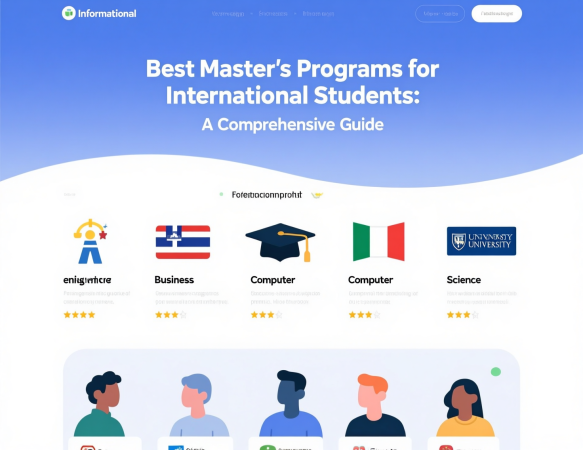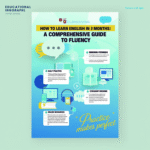Navigating the world of higher education as an international student can be both exhilarating and daunting. The pursuit of a master’s degree abroad opens doors to global career opportunities, cultural immersion, and academic excellence. However, with thousands of programs across the world, choosing the best master’s programs for international students requires careful consideration of academic quality, visa policies, financial aid, and career prospects. This guide provides an in-depth exploration of top-tier master’s programs tailored to the needs of international students, offering detailed insights into program structures, admission requirements, and support systems to ensure success.
- Why Pursue a Master’s Degree as an International Student?
- Top Disciplines for International Students
- 1. Business and Management
- Why Choose Business and Management?
- Top Programs
- Admission Requirements
- Support for International Students
- 2. Engineering and Technology
- Why Choose Engineering and Technology?
- Top Programs
- Admission Requirements
- Support for International Students
- 3. Data Science and Analytics
- 4. Public Health
- Regional Highlights: Best Countries for Master’s Programs
- Key Factors to Consider When Choosing a Master’s Program
- 1. Academic Reputation and Accreditation
- 2. Financial Considerations
- 3. Visa and Immigration Policies
- 4. Language of Instruction
- 5. Career Support and Employability
- Application Process for International Students
- 1. Research and Shortlist Programs
- 2. Meet Admission Requirements
- 3. Secure Funding
- 4. Apply for a Student Visa
- 5. Prepare for Departure
- Challenges and Solutions for International Students
- Success Stories: International Graduates Thriving Globally
- Recommendations for Choosing the Best Master’s Program
- Frequently Asked Questions (FAQs)
Why Pursue a Master’s Degree as an International Student?
A master’s degree is a transformative step for international students seeking to enhance their expertise, expand their professional networks, and gain a competitive edge in the global job market. Universities worldwide design programs to attract diverse talent, fostering environments where cross-cultural collaboration thrives. These programs not only impart advanced knowledge but also equip students with skills to navigate dynamic industries.
-
Global Recognition: Degrees from top institutions are respected worldwide, enhancing employability.
-
Cultural Exposure: Studying abroad immerses students in new perspectives, languages, and traditions.
-
Career Advancement: Specialized master’s programs align with industry demands, preparing graduates for leadership roles.
-
Networking Opportunities: Access to international alumni networks and industry connections fosters long-term career growth.
For international students, selecting a program that balances academic rigor with practical support—such as visa assistance and language resources—is critical. Below, we explore the best master’s programs for international students, categorized by discipline, region, and unique offerings.
Top Disciplines for International Students
The choice of discipline significantly influences career outcomes. Based on global demand and employability, the following fields stand out for international students pursuing a master’s degree.
1. Business and Management
Business and management programs, particularly Master of Business Administration (MBA) degrees, remain a top choice for international students due to their versatility and global applicability. These programs develop leadership, strategic thinking, and entrepreneurial skills, preparing graduates for roles in finance, marketing, consulting, and more.
Why Choose Business and Management?
-
Global Demand: Multinational corporations seek graduates with cross-cultural business acumen.
-
High ROI: MBAs often lead to high-paying roles, offsetting tuition costs.
-
Flexible Specializations: Options include finance, marketing, supply chain management, and entrepreneurship.
Top Programs
-
Harvard Business School (USA): The Harvard MBA is renowned for its case-study method, fostering critical thinking and leadership. International students benefit from a robust career services team, visa support, and a global alumni network of over 80,000 professionals. The program emphasizes experiential learning through field projects and internships, with 50% of students being international.
-
INSEAD (France/Singapore): INSEAD’s one-year MBA program is designed for global professionals, with campuses in Europe, Asia, and the Middle East. Its diverse cohort (90% international students) and bilingual options (English and French) make it ideal for cross-cultural learning. The program offers personalized career coaching and access to 300+ recruiters annually.
-
London Business School (UK): LBS offers a flexible MBA with durations of 15–21 months, allowing customization based on career goals “‘Best Master’s Programs for International Students’”. The school’s location in London provides access to Europe’s financial hub, with 90% of graduates securing jobs within three months.
Admission Requirements
-
Bachelor’s degree (any discipline)
-
GMAT/GRE scores (average: 700+ for top programs)
-
2–5 years of work experience
-
English proficiency (TOEFL/IELTS)
-
Letters of recommendation and essays
Support for International Students
-
Dedicated visa advisors
-
Scholarships (e.g., INSEAD Diversity Scholarship, LBS Sloan Fellowship)
-
Language support and cultural integration workshops
2. Engineering and Technology
Engineering and technology programs attract international students due to the global demand for STEM professionals. Fields like computer science, artificial intelligence, and renewable energy offer cutting-edge research opportunities and high employability.
Why Choose Engineering and Technology?
-
Innovation-Driven: Programs emphasize emerging technologies like AI, robotics, and sustainable energy.
-
STEM OPT Benefits: In the USA, STEM graduates qualify for up to 36 months of Optional Practical Training (OPT).
-
Lucrative Careers: Median salaries for engineers exceed $100,000 in many countries.
Top Programs
-
Massachusetts Institute of Technology (MIT, USA): MIT’s Master of Science in Computer Science is a leader in innovation, offering specializations in AI, cybersecurity, and data science. International students benefit from MIT’s global research partnerships and career fairs, with 95% employment rates post-graduation “‘Best Master’s Programs for International Students’”.
-
ETH Zurich (Switzerland): Known for producing Nobel laureates, ETH Zurich offers master’s programs in mechanical engineering, electrical engineering, and robotics. Low tuition fees (approximately $1,500/year) and English-taught courses make it accessible for international students.
-
Nanyang Technological University (NTU, Singapore): NTU’s Master of Science in Artificial Intelligence integrates industry projects with academic rigor. Singapore’s strategic location and thriving tech ecosystem provide internship and job opportunities.
Admission Requirements
-
Bachelor’s degree in a related field
-
GRE scores (for some programs)
-
Strong academic record (GPA 3.5+)
-
English proficiency (TOEFL/IELTS)
-
Research or work experience (preferred)
Support for International Students
-
STEM OPT extensions (USA)
-
Low-cost tuition (Europe, Asia)
-
Career placement services and industry partnerships
3. Data Science and Analytics
The rise of big data has made master’s programs in data science highly sought after. These programs equip students with skills in machine learning, statistical analysis, and data visualization, preparing them for roles in tech, finance, and healthcare.
Why Choose Data Science?
-
High Demand: Data scientists are among the top 10 most in-demand professionals globally.
-
Versatile Applications: Skills apply across industries, from e-commerce to public policy.
-
Remote Work Opportunities: Many roles offer flexibility for international graduates.
Top Programs
-
Stanford University (USA): Stanford’s Master of Science in Statistics: Data Science combines theoretical foundations with practical applications. The program’s Silicon Valley location offers access to tech giants like Google and Meta.
-
University of Edinburgh (UK): The MSc in Data Science emphasizes interdisciplinary applications, with research opportunities in AI and bioinformatics. International students receive visa guidance and career support.
-
University of Melbourne (Australia): The Master of Data Science integrates industry projects and internships, with a focus on real-world problem-solving. Australia’s post-study work visa (up to 4 years) is a major draw.
Admission Requirements
-
Bachelor’s degree in a quantitative field (e.g., math, computer science)
-
GRE (optional for some programs)
-
Programming skills (Python, R)
-
TOEFL/IELTS for non-native speakers
Support for International Students
-
Post-study work visas
-
Industry-aligned curriculum
-
Scholarships (e.g., Stanford Financial Aid, Edinburgh Global Scholarship)
4. Public Health
Public health master’s programs are ideal for international students passionate about global health challenges. These programs address epidemiology, health policy, and global health equity, preparing graduates for roles in NGOs, governments, and healthcare organizations.
Why Choose Public Health?
-
Global Impact: Graduates address pressing issues like pandemics and healthcare disparities.
-
Diverse Career Paths: Opportunities in policy, research, and community health.
-
Scholarship Availability: Many programs offer funding for international students.
Top Programs
-
Johns Hopkins University (USA): The Master of Public Health (MPH) at Johns Hopkins is globally recognized, with tracks in epidemiology, global health, and health policy. International students benefit from extensive fieldwork opportunities and a strong alumni network.
-
London School of Hygiene & Tropical Medicine (UK): LSHTM’s MSc in Public Health offers specializations in global health and epidemiology. The program’s focus on low-resource settings appeals to students from developing nations.
-
University of Toronto (Canada): The MPH program emphasizes health promotion and policy, with a diverse cohort and access to Canada’s robust healthcare system.
Admission Requirements
-
Bachelor’s degree (any field)
-
Relevant work or volunteer experience
-
TOEFL/IELTS
-
Statement of purpose and letters of recommendation
Support for International Students
-
Fieldwork funding
-
Visa and immigration support
-
Global health networks and internships
Regional Highlights: Best Countries for Master’s Programs
The choice of country is as important as the program itself. Each region offers unique advantages for international students, from affordable tuition to generous post-study work options.
1. United States
The USA hosts some of the world’s top universities, offering diverse master’s programs for international students. With a strong emphasis on research and innovation, U.S. institutions attract global talent.
Advantages
-
World-class faculty and facilities
-
STEM OPT extensions (up to 36 months)
-
Extensive financial aid and scholarships
Challenges
-
High tuition costs ($30,000–$70,000/year)
-
Complex visa processes (F-1 visa)
Top Universities
-
Harvard University: Offers over 100 master’s programs, from education to engineering, with robust international student support.
-
Stanford University: Known for technology and innovation, with programs in data science, business, and environmental studies.
-
MIT: A leader in STEM, with cutting-edge research opportunities.
Support Systems
-
International student offices
-
On-campus employment opportunities
-
Career fairs and networking events
2. United Kingdom
The UK is a hub for master’s programs for international students, with one-year programs that reduce costs and accelerate career entry. Its proximity to Europe and global academic reputation make it a top destination.
Advantages
-
Short program duration (1 year)
-
Graduate Route visa (2–3 years post-study work)
-
Globally recognized degrees
Challenges
-
High living costs in cities like London
-
Competitive admission processes
Top Universities
-
University of Oxford: Offers master’s programs in humanities, sciences, and social sciences, with a focus on research.
-
University College London (UCL): Known for interdisciplinary programs in health, engineering, and policy.
-
Imperial College London: Specializes in STEM and business, with strong industry ties.
Support Systems
-
Dedicated visa advisors
-
Scholarships (e.g., Chevening, Commonwealth)
-
Career workshops and job placement services
3. Canada
Canada’s welcoming immigration policies and high-quality education make it a top choice for international students. Master’s programs here emphasize practical experience and inclusivity.
Advantages
-
Post-Graduation Work Permit (PGWP) up to 3 years
-
Affordable tuition compared to the USA ($15,000–$30,000/year)
-
Multicultural environment
Challenges
-
Cold climate in some regions
-
Limited program availability in smaller cities
Top Universities
-
University of Toronto: Offers diverse programs in health, engineering, and business.
-
University of British Columbia (UBC): Known for sustainability and technology programs.
-
McGill University: Strong in medicine, law, and humanities.
Support Systems
-
International student advisors
-
Co-op programs and internships
-
Settlement services for newcomers
4. Australia
Australia’s vibrant lifestyle and strong education system attract international students. Its master’s programs focus on employability and global perspectives.
Advantages
-
Post-study work visa (2–4 years)
-
High quality of life
-
Industry-aligned curricula
Challenges
-
High tuition and living costs
-
Distance from other continents
Top Universities
-
University of Melbourne: Offers programs in data science, engineering, and arts.
-
Australian National University (ANU): Known for policy, international relations, and sciences.
-
University of Sydney: Strong in health, business, and technology.
Support Systems
-
International student hubs
-
Scholarships (e.g., Australia Awards)
-
Career counseling and job fairs
5. Europe (Germany, Netherlands, Sweden)
European countries like Germany, the Netherlands, and Sweden offer affordable, English-taught master’s programs for international students, making them accessible and appealing.
Advantages
-
Low or no tuition fees (e.g., Germany)
-
English-taught programs
-
Schengen visa benefits for travel
Challenges
-
Language barriers outside the classroom
-
Competitive funding opportunities
Top Universities
-
Technical University of Munich (Germany): Offers low-cost STEM programs.
-
University of Amsterdam (Netherlands): Known for social sciences and business.
-
Lund University (Sweden): Strong in sustainability and innovation.
Support Systems
-
Free language courses
-
Erasmus+ scholarships
-
Integration programs
Key Factors to Consider When Choosing a Master’s Program
Selecting the best master’s programs for international students involves evaluating multiple factors to ensure alignment with academic and career goals.
1. Academic Reputation and Accreditation
-
Choose programs accredited by recognized bodies (e.g., AACSB for business, ABET for engineering).
-
Research university rankings (QS, Times Higher Education) for global standing.
-
Evaluate faculty expertise and research opportunities.
2. Financial Considerations
-
Tuition Fees: Vary widely (e.g., $1,500/year in Germany vs. $50,000/year in the USA).
-
Scholarships: Look for merit-based or need-based funding (e.g., Fulbright, DAAD, Chevening).
-
Cost of Living: Consider expenses in cities like London ($2,000/month) vs. Berlin ($1,000/month).
3. Visa and Immigration Policies
-
Check visa requirements (e.g., F-1 for USA, Tier 4 for UK).
-
Explore post-study work options (e.g., Canada’s PGWP, Australia’s Temporary Graduate Visa).
-
Understand sponsorship processes for employment.
4. Language of Instruction
-
Most top programs are English-taught, but verify proficiency requirements (TOEFL 90+, IELTS 7.0).
-
Some countries (e.g., Germany, France) offer bilingual options.
5. Career Support and Employability
-
Assess career services, internship opportunities, and alumni networks.
-
Research employment rates and industry connections.
-
Prioritize programs with co-op or practical training components.
Application Process for International Students
Applying to master’s programs for international students requires meticulous planning and preparation. Below is a step-by-step guide to streamline the process.
1. Research and Shortlist Programs
-
Use platforms like QS Rankings or university websites to identify programs.
-
Consider program duration, curriculum, and alignment with career goals.
-
Check admission cycles (fall, spring, or rolling).
2. Meet Admission Requirements
-
Academic Transcripts: Provide certified translations if required.
-
Standardized Tests: Submit GMAT/GRE (business, engineering) or TOEFL/IELTS scores.
-
Statement of Purpose (SOP): Highlight academic background, career goals, and reasons for choosing the program.
-
Letters of Recommendation: Obtain 2–3 letters from professors or employers.
-
Resume/CV: Showcase relevant experience and skills.
3. Secure Funding
-
Apply for scholarships early (e.g., Fulbright, Erasmus Mundus).
-
Explore graduate assistantships or part-time work options.
-
Budget for application fees ($50–$150 per university).
4. Apply for a Student Visa
-
Gather documents (acceptance letter, financial proof, passport).
-
Schedule visa interviews early to avoid delays.
-
Understand visa conditions (e.g., work hours, duration).
5. Prepare for Departure
-
Attend pre-departure orientations offered by universities.
-
Arrange accommodation (on-campus or off-campus).
-
Connect with international student communities.
Challenges and Solutions for International Students
Pursuing a master’s degree abroad comes with challenges, but universities offer robust support to ensure success.
1. Cultural Adjustment
-
Challenge: Adapting to new cultural norms and academic expectations.
-
Solution: Participate in orientation programs, join student clubs, and seek counseling services.
2. Language Barriers
-
Challenge: Non-native speakers may struggle with academic English.
-
Solution: Enroll in language workshops or use university writing centers.
3. Financial Strain
-
Challenge: High tuition and living costs.
-
Solution: Apply for scholarships, work part-time (within visa limits), or choose affordable destinations like Germany.
4. Visa and Employment Restrictions
-
Challenge: Navigating complex visa regulations.
-
Solution: Consult university immigration advisors and attend visa workshops.
Success Stories: International Graduates Thriving Globally
To illustrate the impact of master’s programs for international students, consider these real-world examples:
-
Priya Patel (India, Harvard MBA): After completing her MBA, Priya secured a consulting role at McKinsey in Boston, leveraging Harvard’s career services and alumni network.
-
Ahmed Khan (Pakistan, ETH Zurich MS in Robotics): Ahmed’s research at ETH led to a startup in autonomous vehicles, supported by Switzerland’s innovation ecosystem.
-
Maria Gonzalez (Mexico, LSHTM MSc Public Health): Maria now works with the WHO, applying her expertise in global health policy.
These stories highlight how top programs empower international students to achieve their dreams.
Recommendations for Choosing the Best Master’s Program
To select the best master’s programs for international students, we recommend:
-
Prioritize Fit: Choose programs aligned with your academic and career goals.
-
Research Thoroughly: Compare curricula, faculty, and alumni outcomes.
-
Plan Finances Early: Apply for scholarships and explore cost-effective destinations.
-
Leverage Support Systems: Utilize university resources for visas, housing, and career planning.
-
Network Actively: Engage with professors, peers, and alumni to build connections.
Frequently Asked Questions (FAQs)
-
What are the best master’s programs for international students?Top programs include Harvard MBA, MIT’s MS in Computer Science, and LSHTM’s MSc in Public Health, known for academic excellence and international support.
-
Which countries offer the most affordable master’s programs?Germany, Norway, and Finland offer low or no tuition fees, with English-taught programs.
-
What are the visa requirements for studying abroad?Requirements vary (e.g., F-1 for USA, Tier 4 for UK). Generally, you need an acceptance letter, financial proof, and a valid passport.
-
Can international students work while studying?Yes, most countries allow part-time work (20 hours/week) during studies, subject to visa conditions.
-
What is the duration of master’s programs?Typically 1–2 years, with the UK offering one-year programs and the USA favoring two-year programs.
-
Are scholarships available for international students?Yes, programs like Fulbright, Chevening, and DAAD offer funding for international students.
-
How important is English proficiency for admission?Critical. Most programs require TOEFL (90+) or IELTS (7.0) scores.
-
What is STEM OPT in the USA?STEM graduates can extend their Optional Practical Training by up to 36 months.
-
Can I stay and work after completing my master’s?Many countries offer post-study work visas (e.g., 2–3 years in the UK, 3 years in Canada).
-
How do I choose between an MA and an MSc?MA programs focus on humanities and social sciences, while MSc programs emphasize STEM fields. Choose based on your career goals.
-
What is the cost of living for international students?Varies by country (e.g., $1,000/month in Germany, $2,000/month in the UK).
-
Are online master’s programs suitable for international students?Yes, but ensure the program is accredited and offers visa-compliant options for practical training.
-
How competitive are admissions for top master’s programs?Highly competitive. Strong academics, test scores, and relevant experience are essential.
-
What support do universities offer for international students?Visa assistance, language workshops, career services, and cultural integration programs.
-
How can I improve my chances of admission?Craft a compelling SOP, secure strong recommendations, and highlight relevant experience.











